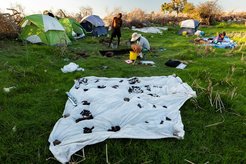Human History on the Island of Madagascar

Madagascar, a large island sitting off the southeastern coast of the African continent, is a critical location for exploring past human migrations, adaptations to climate change, and anthropogenic influences on the environment. Today, the country faces some of the most severe threats in terms of species extinctions, habitat degradation, and economic stability anywhere in the world.
While much is still unclear, it now seems that humans arrived to Madagascar from various places in the past, with early arrivals from Africa being joined by seafaring populations with links as far off as southeast Asia. This diverse history of occupation has resulted in a rich linguistic and cultural heritage, as well as the arrival of different forms of land use and species.
This project uses combinations of field research (e.g., survey, excavation, sediment coring, and modern plant and animal specimen collection) and laboratory analysis (e.g., microfossil inventories and chemical analyses of plants and bones) to investigate human history on the island of Madagascar, including the following longstanding questions:
- When did humans arrive on Madagascar? How did different pulses of arrival vary in terms of their material culture and economic strategies?
- What forms of land use and which species did different groups of humans bring with them?
- How did different human groups, from hunter-gatherers to herders, from village dweller to town residents, respond to climate changes documented over the course of the Holocene?
- How did different human groups, in turn, impact the environments of Madagascar? How have these activities left legacies for communities living in the region today?
The project ties together a diversity of laboratories within the Department of Archaeology and beyond and involves close cooperation with Malagasy collaborators in the context of fieldwork and policy implications.











